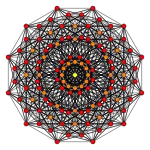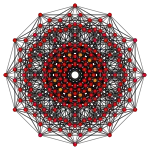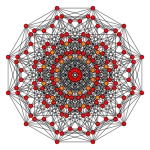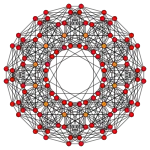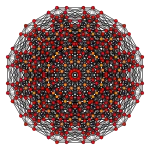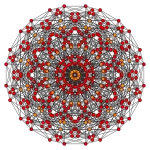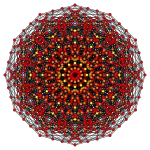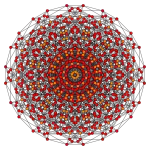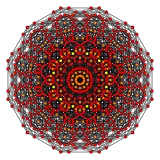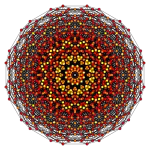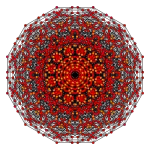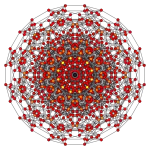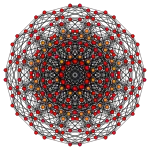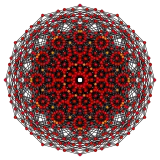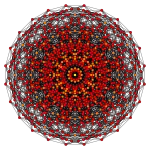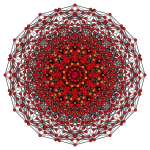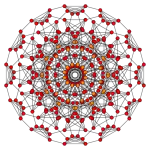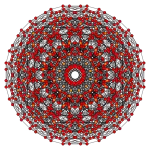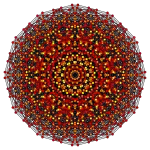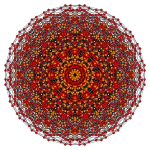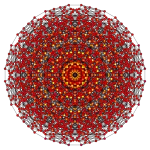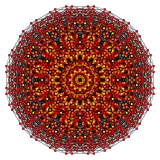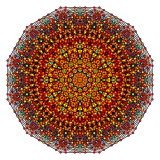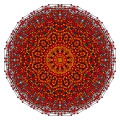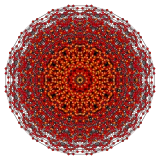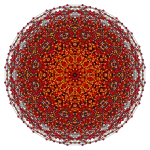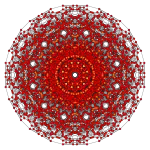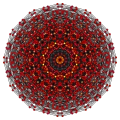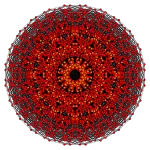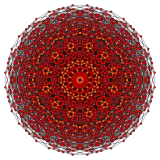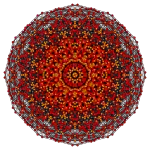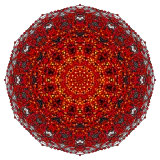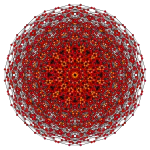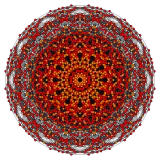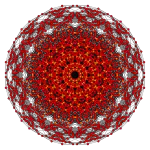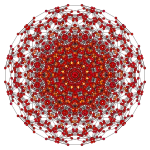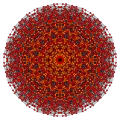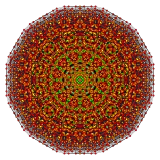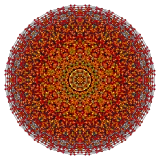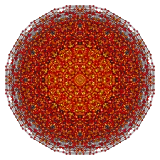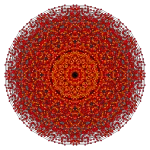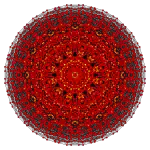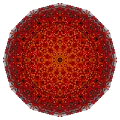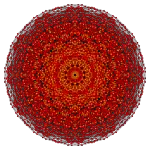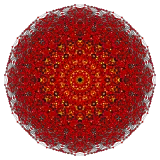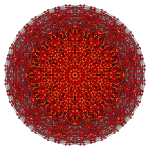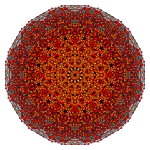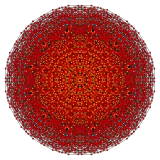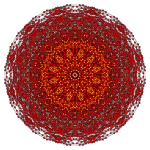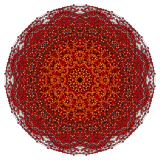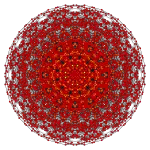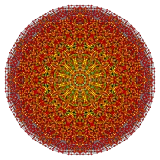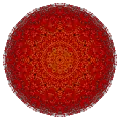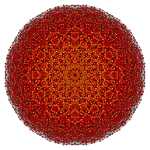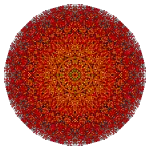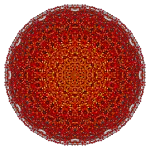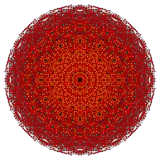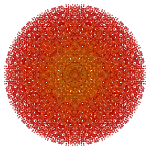6-cube
In geometry, a 6-cube is a six-dimensional hypercube with 64 vertices, 192 edges, 240 square faces, 160 cubic cells, 60 tesseract 4-faces, and 12 5-cube 5-faces.
| 6-cube Hexeract | |
|---|---|
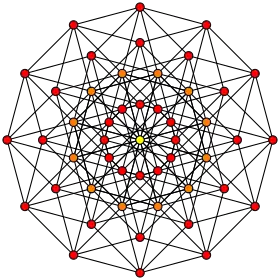 Orthogonal projection inside Petrie polygon Orange vertices are doubled, and the center yellow has 4 vertices | |
| Type | Regular 6-polytope |
| Family | hypercube |
| Schläfli symbol | {4,34} |
| Coxeter diagram | |
| 5-faces | 12 {4,3,3,3} |
| 4-faces | 60 {4,3,3} |
| Cells | 160 {4,3} |
| Faces | 240 {4} |
| Edges | 192 |
| Vertices | 64 |
| Vertex figure | 5-simplex |
| Petrie polygon | dodecagon |
| Coxeter group | B6, [34,4] |
| Dual | 6-orthoplex |
| Properties | convex |
It has Schläfli symbol {4,34}, being composed of 3 5-cubes around each 4-face. It can be called a hexeract, a portmanteau of tesseract (the 4-cube) with hex for six (dimensions) in Greek. It can also be called a regular dodeca-6-tope or dodecapeton, being a 6-dimensional polytope constructed from 12 regular facets.
Related polytopes
It is a part of an infinite family of polytopes, called hypercubes. The dual of a 6-cube can be called a 6-orthoplex, and is a part of the infinite family of cross-polytopes.
Applying an alternation operation, deleting alternating vertices of the 6-cube, creates another uniform polytope, called a 6-demicube, (part of an infinite family called demihypercubes), which has 12 5-demicube and 32 5-simplex facets.
As a configuration
This configuration matrix represents the 6-cube. The rows and columns correspond to vertices, edges, faces, cells, 4-faces and 5-faces. The diagonal numbers say how many of each element occur in the whole 6-cube. The nondiagonal numbers say how many of the column's element occur in or at the row's element.[1][2]
Cartesian coordinates
Cartesian coordinates for the vertices of a 6-cube centered at the origin and edge length 2 are
- (±1,±1,±1,±1,±1,±1)
while the interior of the same consists of all points (x0, x1, x2, x3, x4, x5) with −1 < xi < 1.
Construction
There are three Coxeter groups associated with the 6-cube, one regular, with the C6 or [4,3,3,3,3] Coxeter group, and a half symmetry (D6) or [33,1,1] Coxeter group. The lowest symmetry construction is based on hyperrectangles or proprisms, cartesian products of lower dimensional hypercubes.
| Name | Coxeter | Schläfli | Symmetry | Order |
|---|---|---|---|---|
| Regular 6-cube | {4,3,3,3,3} | [4,3,3,3,3] | 46080 | |
| Quasiregular 6-cube | [3,3,3,31,1] | 23040 | ||
| hyperrectangle | {4,3,3,3}×{} | [4,3,3,3,2] | 7680 | |
| {4,3,3}×{4} | [4,3,3,2,4] | 3072 | ||
| {4,3}2 | [4,3,2,4,3] | 2304 | ||
| {4,3,3}×{}2 | [4,3,3,2,2] | 1536 | ||
| {4,3}×{4}×{} | [4,3,2,4,2] | 768 | ||
| {4}3 | [4,2,4,2,4] | 512 | ||
| {4,3}×{}3 | [4,3,2,2,2] | 384 | ||
| {4}2×{}2 | [4,2,4,2,2] | 256 | ||
| {4}×{}4 | [4,2,2,2,2] | 128 | ||
| {}6 | [2,2,2,2,2] | 64 |
Projections
| Coxeter plane | B6 | B5 | B4 |
|---|---|---|---|
| Graph |  |
 |
 |
| Dihedral symmetry | [12] | [10] | [8] |
| Coxeter plane | Other | B3 | B2 |
| Graph |  |
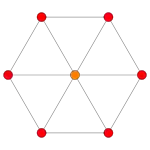 |
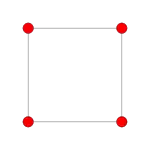 |
| Dihedral symmetry | [2] | [6] | [4] |
| Coxeter plane | A5 | A3 | |
| Graph | 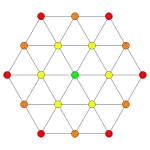 |
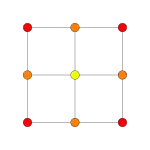 | |
| Dihedral symmetry | [6] | [4] |
| 3D Projections | |
6-cube 6D simple rotation through 2Pi with 6D perspective projection to 3D. |
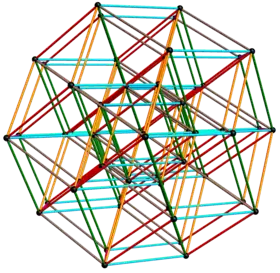 6-cube quasicrystal structure orthographically projected to 3D using the golden ratio. |
Related polytopes
This polytope is one of 63 uniform 6-polytopes generated from the B6 Coxeter plane, including the regular 6-cube or 6-orthoplex.
References
- Coxeter, Regular Polytopes, sec 1.8 Configurations
- Coxeter, Complex Regular Polytopes, p.117
- Coxeter, H.S.M. Regular Polytopes, (3rd edition, 1973), Dover edition, ISBN 0-486-61480-8 p. 296, Table I (iii): Regular Polytopes, three regular polytopes in n-dimensions (n>=5)
- Klitzing, Richard. "6D uniform polytopes (polypeta) o3o3o3o3o4x - ax".
External links
- Weisstein, Eric W. "Hypercube". MathWorld.
- Olshevsky, George. "Measure polytope". Glossary for Hyperspace. Archived from the original on 4 February 2007.
- Multi-dimensional Glossary: hypercube Garrett Jones


